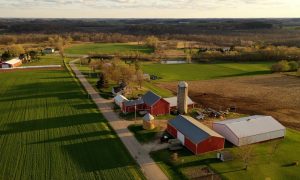Understanding collateral in agricultural financing
There are several factors in helping decide whether the Agri-Access Scorecard loan program is an option for your borrower. Some of these factors include transaction size and obligation to the borrower, but also the valuation and use of collateral. In this blog, we’ll take a closer look at collateral as it pertains to the Scorecard program.
What is the Scorecard program?
The Agri-Access Scorecard program is a lending product that offers an expedited option for borrowers. With a simplified online application that requires less information, ag lenders can get credit decisions for their clients in less than 24 hours for loans up to $2.5M and in less than 48 hours for loans between $2.5M and $4.0M. It’s one way Agri-Access can help community banks offer competitive lending products.
Scorecard has caps on the percentage of the loan Agri-Access can participate in, and that’s based on the total Loan-To-Value (LTV). Here’s what we can finance:
- Up to 75% LTV for loans between $50,000 and $500,000
- Up to 65% LTV for loans between $500,001 and $3,000,000
- Up to 55% LTV for loans between $3,000,001 and $4,000,000
Which collateral qualifies for Scorecard financing?
The entry point into Scorecard is borrowers that use property for agriculture income. Generally, land used for pasture and crops can be applied as collateral to reach the LTV ratio to participate in the loan.
But many ag properties have more than bare land. Sometimes, borrowers may wish to offer facilities and other improvements as a substantial percentage of their loan collateral. Before proceeding, it’s useful to know how and when collateral triggers additional information requirements in Scorecard.
In the following, we provide noteworthy examples.
When ag collateral triggers a review
The following collateral could trigger additional review in Scorecard, particularly if these exceed 50% of the total appraised value. Unless they can balance the ratios by offering acres of bare land as additional collateral, a Traditional Loan program might be a better fit for these borrowers.
- Land uses that could significantly impact the value of the ag land, particularly land used for non-ag purposes, such as residential, commercial or industrial uses.
- Properties that are less than 20 acres
- Improvements to ag land, such as barns, sheds and residences
- Permanent plantings
- Highly specialized facilities
Highly specialized facilities
On the loan application, highly specialized facilities — including things like animal-specific barns or processing plants — should not exceed more than 25% of the total collateral. If the borrower can’t avoid keeping it at or below 25%, a Traditional loan program through Agri-Access will be recommended. Because such facilities were built for specific uses, more information about the borrower and their operation would need to be gathered to make a full risk assessment.
Examples of a borrower with a special use facility: Bob Nelson is interested in a $75,000 ag loan through Scorecard. To reach the LTV target percentage, he needs $100,000 in collateral.
Bob Nelson offers a hog barn valued at $100,000. Scorecard can apply up to 25% of the value of a specific use facility as collateral — or $25,000. So Bob is advised of two options:
- Option A: Continue pursuing Scorecard by lowering the loan amount or pledge additional collateral, such as bare land.
- Option B: Continue offering the barn as collateral, but pursue a Traditional analysis rather than Scorecard. (Because he has solid projections to show he has sufficient cash flow to repay the $75,000 loan, along with good credit history, he’s a great candidate.)
If a borrower plans to transition the asset to another use — one that isn’t agricultural — then this collateral is not eligible for Scorecard.
Farm & Ranch Real Estate Desktop Valuation Program
If you’re seeking assistance to help finance your clients’ agricultural loans, our teams are ready to speak with you. In addition to our loan programs, we provide affordable and quick solutions for accessing your client’s collateral value through our Farm & Ranch Real Estate Desktop Evaluation Program. Managed collaboratively with the Agri-Access appraisal team, this program approves Qualified Evaluators from your lending institution, to submit a Valuation Report in lieu of a Uniform Standards of Professional Appraisal Practice (USPAP). To learn more about becoming a Qualified Evaluator and the Valuation Report, e-mail [email protected] or contact a Relationship Manager in your area.

